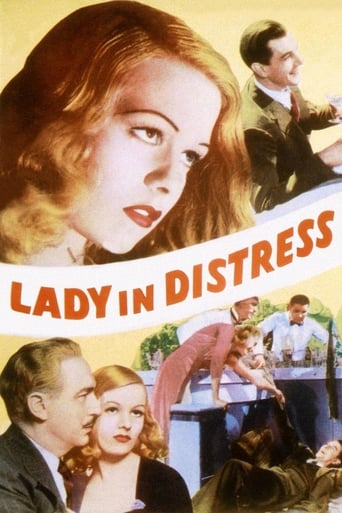boblipton
Michael Redgrave is on the train to his job as a crane operator. He sees at a window Paul Lukas killing Sally Gray.It's a great start for a movie, and it was used before. LADY IN DISTRESS is a remake of the French METROPOLITAIN. I'd like to offer you a comparison of the two movies, but I've never seen the earlier film. I do know that Michael Redgrave is miscast as a working stiff who rides around in taxicabs. Sally Gray, on the other hand, impresses me as more than eye candy with a sullen expression for the first time. She's very good as the unwilling femme fatale who drives her husband, stage magician Lukas, crazy with jealousy, talent manager Hartley Power, sad with hopelessness and Redgrave mad with the possibilities of a magical night.There are many early noir elements in this movie, filled, as it is, with Gallic fatalism, and can be viewed as an important step in its evolution. It's just not a film noir in itself.
writers_reign
In the past decade I've watched several British films produced in the lat 1930s - including Climbing High which featured Michael Redgrave - and all were risible despite names like Ralph Richardson and Carol Reed adorning the credits so I wasn't expecting too much when I opted for this but as a great admirer of Michael Redgrave I went along and was presently surprised. It's not, of course, without flaws - Michael Redgrave is arguably the least convincing crane driver in the history of film and how many crane drivers sport a display handkerchief in the breast pocket of a suit and/or frequent West End night clubs, but if we overlook this - plus the fact that Redgrave, having seen what appears to be a murder through the window of 1) a train on which he is passenger and 2) the window of a flat in a large block, is then able to leave the train at the next station and identify not only the anonymous apartment block but also the flat in which the incident took place - we are left with a tasty little thriller, excellently cast with Paul Lukas and Sally Gray as the husband and wife in the window and Patricia Roc as Redgrave's wife. There's a fair amount of location shooting - Redgrave is actually helping construct Waterloo Bridge - and the scenes inside a theatre have a flair and polish sadly lacking in Hitchcock's similar attempts. Albert Prejean and Ginette Leclerc starred in the French original 'Metropolitan' which by all accounts was greatly inferior. I'd definitely buy this on DVD were it available.
howardmorley
In 1938 Paul Lukas and Michael Redgrave crossed swords in the acclaimed "The Lady Vanishes" and here two years on they have another bout with the illusionist Zoltini played by Paul Lukas and Michael Redgrave as Peter from their respective former roles of Dr.Harz and Gilbert.This time Patricia Roc plays Pat, Peter's wife while "hot totty" Sally Gray plays Vivienne married to Zoltini.Other reviewers have discussed the basic plot and no I won't provide a spoiler as there is a kick in the end of the film which is well produced.I wonder how many buildings survived the forthcoming blitz from 1940 onwards as there are some interesting shots of London filmed in 1939 with the tube trains running.I found the screenplay somewhat contrived especially the scene where the tycoon misses his plane to Moscow which crashed because telephonist Pat failed to first warn him about his flight.However this incident gives the producer the excuse to follow the moral cinema code and enabled both Pat and Peter to go to both work together during the day and not continue with their "Cox & Box" sleeping arrangements.Peter had a job keeping his hands off Sally Gray's character and remembering his marriage vows.Offstage, blonde Sally Gray married a lord and lived to be 90 and her husband to 100!Imdb.com rated this film 6.9 when I wrote this review and I rated it 6 as above average.
kinekrom
From a train window, crane-driver Michael Redgrave thinks he sees a woman being strangled. What follows is an unusual and effective story involving a magician, his assistant wife and a subtle interplay of illusion and murder. Refreshingly directed by the overlooked Herbert Mason, and well performed throughout (particularly Redgrave and Sally Gray), this small gem benefits greatly from its varied and credible London backgrounds, including music halls (including magic shows), mundane work places not normally seen in British films of the period, and construction work on Waterloo Bridge, under which the National Film Theatre is situated (which is where I last saw this film).


